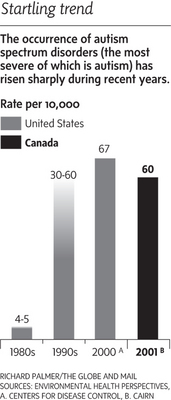But a U.S. researcher is advancing a controversial hypothesis: that autism is related to vitamin D deficiency during fetal development and early childhood.
Dr. John Cannell, a psychiatrist and prominent vitamin D advocate, says flagging levels of the vitamin in pregnant women and young children could be the elusive factor explaining the rising rate of autism.
The evidence for such a link is circumstantial, and autism experts describe the hypothesis as speculative. But Dr. Cannell, founder of the Vitamin D Council, a non-profit advocacy group, says autism rates have skyrocketed in lockstep with medical advice given to the public since the late 1980s to avoid all exposure to bright sunshine.

|
| ©Globa and Mail |
"If it's true, I can't think of another situation where medical advice was so damaging to such a large number of people," says Dr. Cannell, who practises at Atascadero State Hospital in California.
The vitamin D link "is an interesting speculation," says Dr. Wendy Roberts, a professor of pediatrics at the University of Toronto and one of Canada's leading autism experts.
Because the cause of autism is such an enigma, Dr. Roberts says researchers should investigate vitamin D, but the public should treat the idea more cautiously.
"You like to be able to have something that is firm and clear before you get parents all excited and doing something and then, once again, being disappointed," she said.
Although Dr. Cannell is something of a maverick in research circles, he has credentials. Last year, he published an important peer-reviewed paper linking low vitamin D levels to an increased susceptibility to influenza, based on research at his hospital.
But for his autism hypothesis, he is now jeopardizing his chances of publication in a scientific journal by e-mailing the Vitamin D Council newsletter outlining the idea to thousands of U.S. autism activists - a possible violation of the rules of publication.
Dr. Cannell said he decided to disseminate his hypothesis now to encourage the public to increase its sun exposure during the warmer part of the year.
"If only 10 pregnant women go outside and sunbathe a little bit, they may be saved a lifetime of misery," he said.
The idea that vitamin D deficiency may have a link to autism isn't as farfetched as it once might have seemed because the deficiency is also emerging as a possible cause of many diverse illnesses, ranging from multiple sclerosis to cancer.
Last month, the Canadian Cancer Society recommended adults start taking the sunshine vitamin to reduce their risk of cancer.
Autism refers to a spectrum of conditions that involve repetitive behaviours and difficulty communicating and interacting socially. Autism manifests itself in the first few years of life and is thought to be some kind of neurological disorder affecting brain function.
One discredited theory is that the mercury-containing preservative thimerosal once used in childhood vaccines causes autism. Studies have failed to find any link.
The cause of autism is further clouded because some scientists speculate that part of the apparent increase in incidence - in the United States it is being diagnosed about 10 times more frequently now than in the early 1990s - may reflect improved reporting by doctors more aware of the condition.
The current Canadian estimate is that about 60 children out of every 10,000, or about 1 in 165, have autism and related conditions. Up until the 1990s, the prevalence was thought to be far lower, at only 4 or 5 children in 10,000.
If there is a vitamin D link, incidence rates around the world would probably vary by latitude. Rates would be lower in equatorial areas, where sun exposure is higher, than in northern latitudes, but studies investigating geographical differences in diagnosis haven't been done.
Dr. Cannell says some of the strongest evidence vitamin D may have a hand in the disorder is that the vitamin is converted in the body to a steroid hormone, which in animal experimentation has been found to influence brain development. If vitamin levels are low, whatever brain development it is linked to will be skewed.
Startling trend
The occurrence of autism spectrum disorders (the most sever of which is autism) has risen sharply during recent years.
Rate per 10,000
UNITED STATES
1980s: 4-5
1990s: 30-60
2000A: 67
CANADA
2001B: 60
SOURCES: ENVIRONMENTAL HEALTH PERSPECTIVES
A- CENTRES FOR DISEASE CONTROL
B-CAIRN



Yes, that's why - it's vitamin D, no, really, it is. Well, ok, it's either vitamin D or that nasty leprechaun that has been following me around, but one thing is for sure it's just not thimerosal - no matter what the clinical studies, doctor testimonies, permanently damaged children and anguished parents tell you!